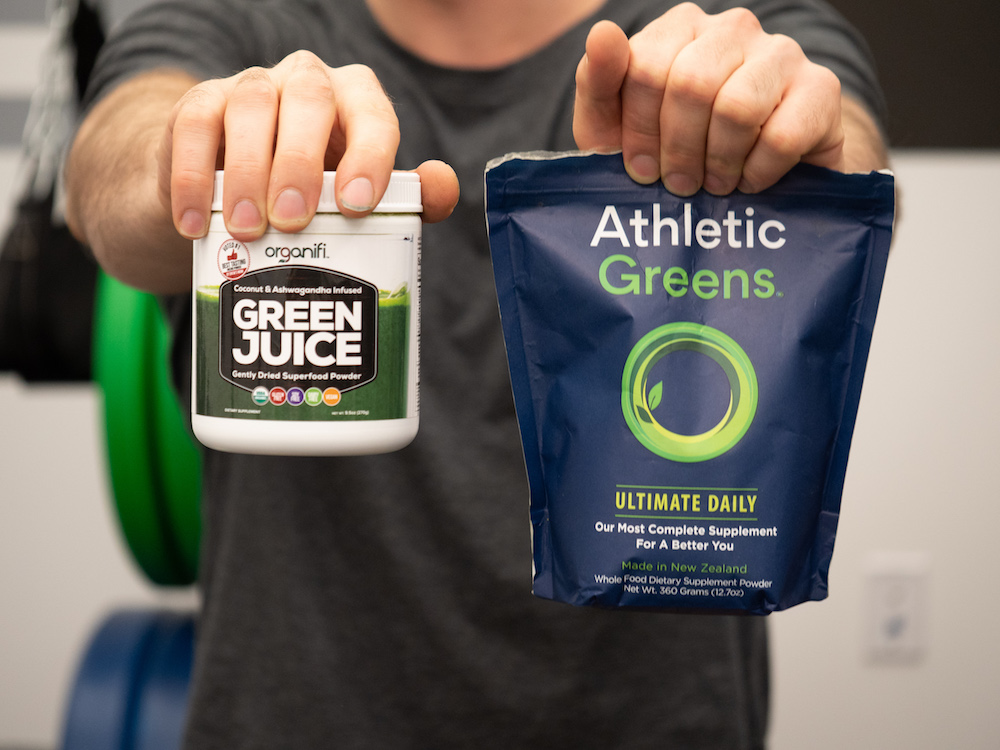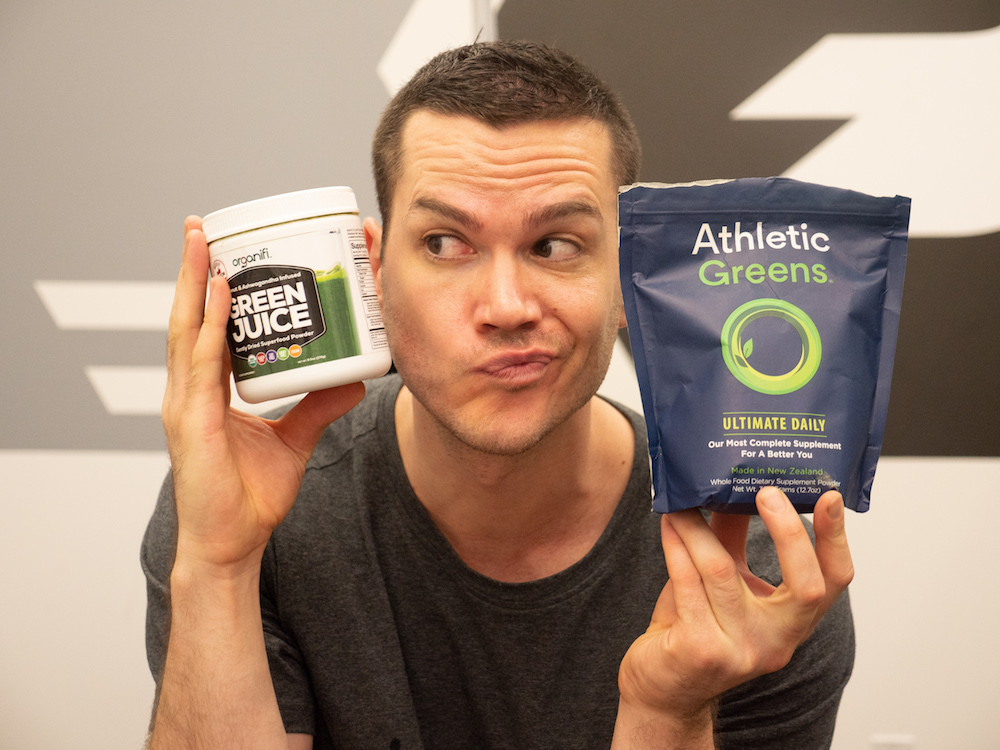If there’s ever been an ultimate face-off between titans of the green superfood powder industry, this is it. These two companies are enormously influential and many consider them the default option when discussing greens supplements.
In one corner we have Athletic Greens, the powder that entrepreneur god-king Tim Ferriss once called his go-to supplement and Joe Rogan has called “the most complete whole food supplement you can find.” Packed with a variety of antioxidant-rich greens along with mushrooms, probiotics, and a few other goodies we’ll get into below, this product has an unusually long list of ingredients and potential effects.
In the other corner there’s Organifi Green Juice, a slightly younger product that’s promoted by a Facebook page with over two million “likes”. While it also contains popular green superfood ingredients like wheatgrass and chlorella, it’s very different from Athletic Greens in that it has far fewer ingredients. Does this mean they focus on quality over quantity?
Let’s take a closer look.
Athletic Greens Vs. Organifi Nutrition
Athletic Greens
One serving of Athletic Greens contains forty calories, 4.8 grams of carbs, 1.9 grams of fiber and 4 grams of protein.
As for micronutrients, there’s a lot to talk about.
Besides a day’s worth of zinc, 35 percent of your selenium, 20 percent of your daily chromium and manganese, there aren’t all that many minerals. But there are lot of vitamins: 700 percent of the recommended daily intake of Vitamin C, about 100 percent of most B-vitamins, a day’s K2, 80 percent of your day’s Vitamin A, and over 300 percent of your Vitamin E intake.
[Get 20% off Athletic Greens with this link!]
Organifi
There’s a lot less nutrition here, or at least a lot less on the nutrition label. A scoop has 30 calories and 2 grams of protein, 4 grams of carbs, and 4 grams of fiber.
On the micronutrient side, the most impressive aspect is the 11 percent of your daily iron. (Oddly, iron is one of the few nutrients that isn’t listed on Athletic Greens.) Besides that there’s 1 percent of your sodium and 3 percent of your calcium. And zero vitamins.
You wouldn’t want to take this as a supplement for vitamins and minerals, but green superfood powders are more about the ingredients and their potential non-vitamin-y, non-mineral-y effects.
[Shop Organifi Green Juice HERE.]

Athletic Greens Vs. Organifi Ingredients
Athletic Greens
There are seventy-five ingredients in Athletic Greens. Every one of them is listed in our full Athletic Greens review but we’ll give a brief overview of the four proprietary blends.
Alkaline, Nutrient-Dense, Raw Superfood Complex (8,453mg): A variety of greens including powdered spirulina, wheatgrass juice, chlorella, and barley leaf, along with some fruits (like goji and blueberry) and vegetables (like spinach and beet root). It’s also notable that there are some other ingredients known to be high in antioxidants liek green tea leaf extract and cocoa bean polyphenol extract.
Nutrient Dense Natural Extracts, Herbs, and Antioxidants (3,569mg): This blend has a bit more of an emphasis on adaptogenic herbs like rhodiola rosea, ginseng, milk thistle seed, and ashwagandha.
Digestive Enzyme & Super Mushroom Complex (233mg): Astragalus root extract, bromelain, burdock root powder, reishi mushroom powder, shiitake mushroom powder.
There are also 7.2 billion probiotic bacteria from Lactobacillus Acidophilus and Bifidobacterium Bifidum.
[Read our complete Athletic Greens review here.]
Organifi
Again, there’s less to read on Organifi’s label, but that doesn’t necessarily make it a worse product. The ingredients are split into blends as well:
Alkaline Greens Proprietary Blend (5.1 grams): wheatgrass, moringa oleifera (also called horseradish tree leaf), spirulina, chlorella, and matcha green tea.
Super Food Proprietary Blend (1.45 grams): coconut water powder, ashwagandha root extract, red beet root, and turmeric.
Additional ingredients include prebiotic fiber; lemon, orange, and mint flavor; and monk fruit.
Once again, these are proprietary blends.
[Read our full Organifi Green Juice review here.]

Athletic Greens Vs. Organifi Benefits
Athletic Greens
With seventy-five ingredients, you might be inclined to think this must be the more effective product. But that’s not necessarily true.
For example, let’s talk about adaptogens. These are plants or compounds that are meant to help the body react to stress, be it emotional or physical. Maybe that means they boost your immunity a little, maybe it means they improve workout performance, usually it means they help with cognition.
Athletic Greens has more adaptogens than Organifi: rhodiola, ginseng, ashwagandha, astragalus, reishi mushroom, shiitake mushroom, and so on. But I’m unsure of the dose. Reishi and shiitake mushroom, for example, are usually dosed at about a gram when intended for their adaptogenic effects. But in Athletic Greens, they’re two of five ingredients in a blend of 233 milligrams. Maybe they work synergistically with the other adaptogens but in any case, the doses aren’t really explained.
But there are a lot of other promising effects, here. It has way, way way more vitamins and minerals. It has a ton of ingredients known for their antioxidant content, which may slow cellular degradation. (Some of their advertising claims it has the antioxidants of 12 servings of vegetables, but the antioxidants aren’t quantified on the bag.)
Another big benefit over Organifi? The 7+ billion probiotic bacteria. Probiotics have been linked to everything from better digestion to better immunity and mental health (read our whole article about ’em here). Add all that to the prebiotic fiber and the digestive enzymes and you’ve got a product that doesn’t forget the importance of digestive health.
Organifi
No vitamins on the label, next to no minerals, what is Organifi brining to the table?
First, let’s look at the antioxidants. There are five grams of green, grassy “superfoods” and the first one is wheatgrass, which studies have found to be a lot higher than many vegetables. Now, you typically eat a lot more than 5 grams of vegetables so maybe we’re talking about apples and oranges here (get it?), but it’s fair to say that Organifi likely delivers a hit of antioxidants. They aren’t quantified at all, but that’s a fault shared by Athletic Greens.
Organifi’s label has in big letters “Coconut and Ashwagandha-Infused” and the ashwagandha is pretty interesting. Studies suggest about 300 milligrams is a good minimum dose and with Organifi putting it second on a 1.45-gram blend, it seems likely that it hits this threshold. This Indian herb has been linked to better cognition and lower stress and unlike Athletic Greens, I have pretty solid evidence that we’re at least reaching the recommended dose.
But the coconut is a little baffling. Organifi’s site says coconut has potassium and helps to transport nutrients around the body, but there’s no potassium listed on the nutrition label.
In any case, I like the antioxidants and the ashwagandha.

Athletic Greens Vs. Organifi Price
Athletic Greens
While keeping in mind that prices can change at any time for any reason, Athletic Greens comes in a sack of 30 servings that will run you roughly $90 to $110. You’re looking at about $3.25 per scoop, but if you sign up for monthly subscriptions that price drops to about $2.50 per scoop.
Organifi
Right now, a tub of 30 scoops costs between $60 and $80, so it comes out to roughly $2.25 per scoop — a whole dollar less than Athletic Greens. The price also drops with a subscription or if you buy more than one tub at a time; if you get three monthly tubs you’re looking at $1.50 per scoop.
You can’t argue with numbers: Organifi is the cheaper product.
Athletic Greens Vs. Organifi Taste
Athletic Greens
I’m pretty confident this is the tastiest greens powder I’ve ever tried. Both of these products avoid the soily, earthy taste that’s so common in their contemporaries but Athletic Greens had a really interesting flavor profile that tastes predominantly of vanilla, pineapple, and papaya. There’s a little ginger and carrot in there as well but it’s mostly a creamy, tropical flavor that I actually enjoyed savoring.
In an industry where most products are judged by how hard they are to chug, this is the first one I ever wanted to sip.
Organifi
The grassier of the two products, it’s easier to tell that Organifi has a base of wheatgrass. That said, it has a few flavorings added to it that I mentioned above: organic mint, lemon, orange, and monk fruit.
The main flavors to come through from that? Mostly just the mint and the matcha green tea, so what you wind up with is something that tastes pretty close to mint green tea. (Which, remember, is relatively earthy.) I’d recommend it either very cold (refreshing!) or kind of hot (tea-like!), since a room temperature drink was a little “meh.”
The Takeaway
It’s hard to be certain of anything with all these proprietary blends, but I’m more confident that the Organifi is a good source of adaptogens — or at least, an adaptogen — and the Athletic Greens is a better source of vitamins and antioxidants. It depends on your goal but even though the Organifi is cheaper, I’m personally a bigger fan of the Athletic Greens.